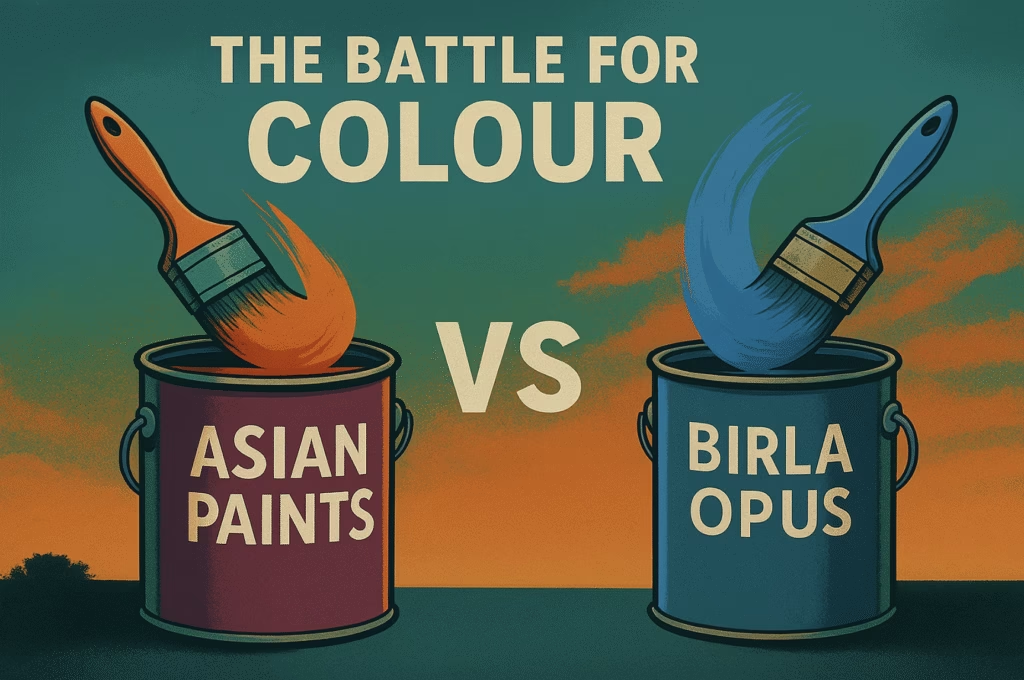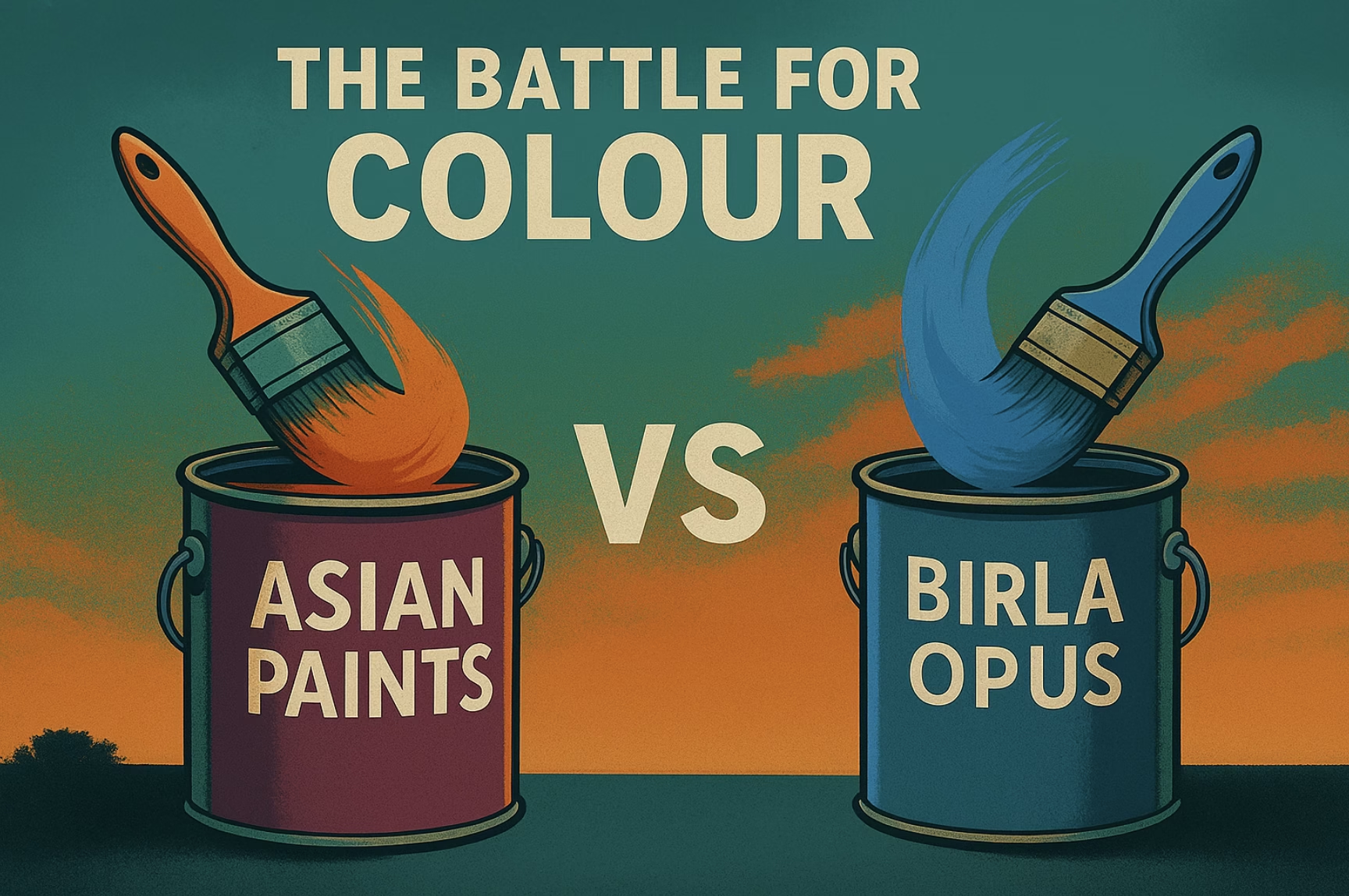India’s paint story is a blend of historic craft and modern industries. From natural pigments used in temples to paint the walls and used as colour, now in the paint industry billion-dollar companies are created and evolved rapidly.

This article traces the journey of paint in India, explains the strategic choices that made Asian Paints a household name in the country, and explains how Birla Opus is changing the industry dynamic.
Quick history and journey of paint/paint industry in India
For millennium, Indians used natural pigments for decoration, textiles, and art. The modern paint industry, however, began in the 20th century. Shalimar Paints opened the first regional large-scale paint plant in 1902; they are the pioneer of the paint industry in India. Over the following decades, imported paints or foreign companies dominated in India, but because of World War II, the supply chain was disrupted and then Indian brands started coming into this area, opening manufacturing units and small firms. Then Asian Paints came into the picture.
What Asian Paints did right
Asian Paints did not become a giant in the paint industry accidentally; they took a few repeatedly strategic decisions that are worth learning about.
Supply chain and distribution
Asian Paints built the classic distribution model. Instead of a long, layered channel, it moved paints to company depots and filled directly to dealers. This caused dealers to reduce their working capital and guaranteed availability of paints when needed, even in smaller cities. This operational discipline made Asian Paints the most loved and reliable brand in India.
Solving choices of colour and inventory challenge by tinting technology
The practical challenge for paint companies is SKUs. In colour, there are thousands of shades but the storage is limited. To solve this problem, Asian Paints invested in tinting dispenser machines and dealer tools that can generate thousands of shades on demand, which simplified the inventory problem and gave customers a lot of choices to pick from. This technical and distribution strategy changed the game for Asian Paints.
Customer experience and digital tools
Asian Paints moved to customer experience also. They started investing in the customer design journey. They launched various tools like Visualiser, Colour Picker App and in-store Colour Idea experience. This helped customers choose colours and make decisions faster. These tools improved conversion and positioned the company as a home décor partner, not just a paint supplier.
Add brands and invest in research and development
Other paint companies are focusing on price, but Asian Paints focused on research and development and broadened into home solutions, decorated homes, created a brand that aligns with categories, and improved lifetime value while reducing price vulnerability.
But now Asian Paints has a big challenge in the paint industry

New challenge for Asian Paints: entry and expansion of Birla Opus
The Aditya Birla Group’s Opus entered as a newcomer to take a meaningful position in a short period of time, and that rapid expansion is the single biggest reason the paint industry feels different today. In a short period of time, Birla Opus became the third-largest paint player and would command 24% of the installed capacity once its sixth plant is operational, to be launched in Kharagpur, West Bengal next month.
Rapid capacity build
Birla Opus is scaling rapidly with a total production capacity of 1,332 million litres per annum with six plants. The five plants currently operational in Panipat (Haryana), Ludhiana (Punjab), Cheyyar (Tamil Nadu), Chamarajanagar (Karnataka) and Mahad (Maharashtra) have a total production capacity of 1,096 million litres per annum. This kind of greenfield investment changed the supply picture almost overnight.
Go-to-market tactics
The company used aggressive pricing, dealer incentives, and strong on-ground execution by hiring experienced personnel from incumbents. Because of this, Birla Opus reported measurable revenue within months and rising share. They are on track to achieve ₹10,000 crore revenue mid-term target by the third year of full-scale operations, and they integrated technology with the industry.
Asian Paints near-term outlook and strategic response
Asian Paints is defending its core strengths while accelerating diversification.
Immediate pressure
The company’s margin and revenue are affected by softened demand and intense competition. While retail demand has shown resilience at times, the combination of discounting and new entrant incentives dented profits in FY24–25.
Strategic priorities
Double down on operational efficiency
Tighter planning, better forecasting and delivering products fast to dealers from depots will increase the margin of the business.
Shift up the value chain
Diversify the portfolio, improve the home décor business and launch aligned categories (bath, kitchen, home furnishings) so revenue becomes less volatile and the company is not dependent on one product.
Protect dealers not just by pricing
The company is launching more loyalty programs, digital tools, and faster deliveries to reduce defections.
Focusing on research and development
Newer formulations and differentiated decorative finishes, creating tools or products, give customers reasons not to buy on price alone.
Conclusion
The Indian paint industry has evolved from natural pigments to new technologies. Asian Paints mastered distribution, managed the supply chain effectively and added new technology like tinting and a shift to home décor experiences. Birla Opus is rapidly increasing capacity, applying go-to-market strategies and investing money in capex. The next few years will be more competitive for businesses and for the industry. Whoever does their work best will lead the market.
